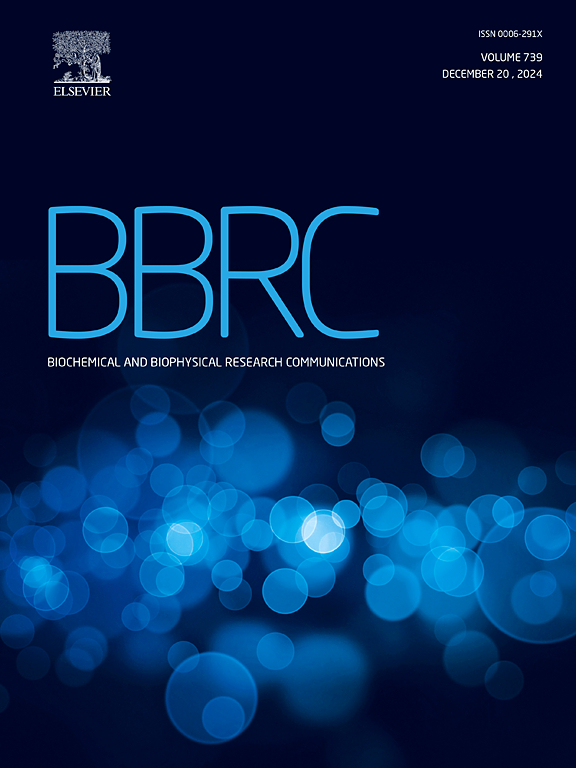mRNA-seq和miRNA-seq综合分析揭示了HNF4α和KLF4在ADPKD中的关键转录因子。
IF 2.5
3区 生物学
Q3 BIOCHEMISTRY & MOLECULAR BIOLOGY
Biochemical and biophysical research communications
Pub Date : 2024-10-18
DOI:10.1016/j.bbrc.2024.150848
引用次数: 0
摘要
常染色体显性多囊肾病(ADPKD)是影响肾脏的最常见遗传疾病。了解表观遗传调控机制和微RNA(miRNA)的作用对于开发治疗干预措施至关重要。研究人员利用来自ADPKD患者的两个mRNA数据集(GSE7869和GSE35831)和miRNA表达数据(GSE133530)来寻找差异表达基因(DEGs)和差异表达miRNAs(DEMs),重点关注受中枢转录因子(TFs)及其靶基因调控的基因。通过 Western Blot (WB) 和 RT-PCR 分析验证了人肾和动物模型中枢转录因子的表达。激光共聚焦显微镜观察了肾脏细胞中枢纽TF蛋白的位置。共鉴定出 2037 个 DEGs。DEM分析得出了59个上调的miRNA和107个下调的miRNA。DEMs预测的目标DEGs显示了两个最主要的失调TFs:肝细胞核因子4α(HNF4α)和Kruppel样因子4(KLF4)。RT-PCR、WB和免疫化学结果显示,与正常对照组相比,人ADPKD肾脏和Pkd1条件性基因敲除小鼠中HNF4α的mRNA和蛋白水平显著下降,而KLF4的水平显著上调。激光共聚焦显微镜显示,KLF4主要位于细胞质中,而HNF4α位于细胞核中。功能富集分析表明,HNF4α调控的基因主要与代谢途径有关,而KLF4调控的基因则与肾脏发育有关。药物反应预测分析揭示了治疗ADPKD的潜在候选药物,包括BI-2536、Sepantronium和AZD5582。这项综合分析为了解ADPKD中复杂的miRNA-TF-mRNA网络提供了新的表观遗传学见解,并确定了HNF4α和KLF4是关键的TF。这些发现为 ADPKD 的进一步研究和潜在药物开发提供了宝贵的资源。本文章由计算机程序翻译,如有差异,请以英文原文为准。
Integrated mRNA-seq and miRNA-seq analysis reveals key transcription factors of HNF4α and KLF4 in ADPKD
Autosomal Dominant Polycystic Kidney Disease (ADPKD) is the most prevalent genetic disorder affecting the kidneys. Understanding epigenetic regulatory mechanisms and the role of microRNAs (miRNAs) is crucial for developing therapeutic interventions. Two mRNA datasets (GSE7869 and GSE35831) and miRNA expression data (GSE133530) from ADPKD patients were used to find differentially expressed genes (DEGs) and differentially expressed miRNAs (DEMs), with a focus on genes regulated by hub transcription factors (TFs) and their target genes. The expression of hub TFs was validated in human kidneys and animal models through Western Blot (WB) and RT-PCR analysis. The location of the hub TF proteins in kidney cells was observed by a laser confocal microscope. A total of 2037 DEGs were identified. DEM analysis resulted in 59 up-regulated and 107 down-regulated miRNAs. Predicted target DEGs of DEMs indicated two top dysregulated TFs: hepatocyte nuclear factor 4 alpha (HNF4α) and Kruppel-like factor 4 (KLF4). RT-PCR, WB, and immunochemistry results showed that mRNA and protein levels of HNF4α were significantly decreased while KLF4 levels were significantly up-regulated in human ADPKD kidneys and Pkd1 conditional knockout mice compared with normal controls. Laser confocal microscopy revealed that KLF4 was mainly located in the cytoplasm while HNF4α was in the nucleus. Functional enrichment analysis indicated that genes regulated by HNF4α were mainly associated with metabolic pathways, while KLF4-regulated genes were linked to kidney development. Drug response prediction analysis revealed potential drug candidates for ADPKD treatment, including BI-2536, Sepantronium, and AZD5582. This integrated analysis provides new epigenetic insights into the complex miRNA-TF-mRNA network in ADPKD and identifies HNF4α and KLF4 as key TFs. These findings offer valuable resources for further research and potential drug development for ADPKD.
求助全文
通过发布文献求助,成功后即可免费获取论文全文。
去求助
来源期刊
CiteScore
6.10
自引率
0.00%
发文量
1400
审稿时长
14 days
期刊介绍:
Biochemical and Biophysical Research Communications is the premier international journal devoted to the very rapid dissemination of timely and significant experimental results in diverse fields of biological research. The development of the "Breakthroughs and Views" section brings the minireview format to the journal, and issues often contain collections of special interest manuscripts. BBRC is published weekly (52 issues/year).Research Areas now include: Biochemistry; biophysics; cell biology; developmental biology; immunology
; molecular biology; neurobiology; plant biology and proteomics

 求助内容:
求助内容: 应助结果提醒方式:
应助结果提醒方式:


